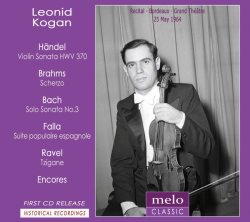|

|
George Frederic HANDEL (1685-1759)
Sonata for Violin and Basso Continuo in E major, Op. 1 No. 15, HWV 373 [9:49]
Johannes BRAHMS (1833-1897)
F.A.E. Sonata; Scherzo (1853) [5:55]
Johann Sebastian BACH (1685-1750)
Sonata for Violin Solo No. 3 in C major, BWV 1005 (1720) [23:40]
Manuel de FALLA (1876-1946)
Suite populaire espagnole (arr. for violin and piano Pawel Kochanski) (1914) [13:22]
Maurice RAVEL (1875-1937)
Tzigane (1924) [8:28]
Claude DEBUSSY (1862-1918)
Beau Soir (c.1880) (transcribed Heifetz) [2:24]
Pablo SARASATE (1844-1908)
Dansas españolas: Zapateado Op. 23 No. 2 (1878-82) [5:49]
Leonid Kogan (violin)
Naum Walter (piano)
rec. 25 May 1964, live, Bordeaux, Grand Theatre
MELOCLASSIC MC2012 [69:31]
In the years following Leonid Kogan’s early death Melodiya put out a big series of gatefold double LPs tracing live concert performances given in Moscow. I bought as many as I could, which was useful because he was never strongly represented in the burgeoning CD catalogue of the late 1980s. Of late things have changed for the better with EMI, Testament and Brilliant just three of the labels to have devoted releases documenting his art. Melodiya has recently begun to step up production too, and now Meloclassic presents its own tribute in the form of a single concert performance given in Bordeaux in May 1964, in excellent sound.
His sonata partner was Naum Walter, with whom he recorded frequently and the repertoire is very much standard Kogan; Handel, Brahms, Bach, Falla, Ravel, Debussy, and Sarasate. There are none of his more exploratory Soviet works, but the French works play well to the audience’s expectations. The Handel was a frequent concert-opener for Kogan. Those who have seen the EMI Classics DVD of the violinist will recall that there is a performance of it with Andrei Mytnik (not Walter) given in London in March 1962. As an aside there is also the filmed Debussy Beau Soir and – with Walter in Paris in 1968 – the Falla. So all these works were very much tried and tested favourites.
His Handel is played with refined purity, subtly deploying greater dynamic variance in the Allegro second movement, and infinitesimally stretching phrases to avoid repetitiousness of material. The Largo is generously expressive without any cheap gestures. For some reason the Scherzo from the FAE sonata sounds a touch less ‘present’ – maybe he moved position slightly – though it hardly matters as he was a distinguished and never petulant Brahmsian and never one to push tempi for their own sake. His solo Bach stands at a remove from that of another player in this series, Christian Ferras, who is altogether a more vigorous and explosive practitioner. For Kogan in the C major sonata, rhythm, precision and an iron-clad control that never precludes phrasal breadth are the keynotes to his art. His Falla Suite populaire, in the famous Kochanski arrangement – if only Kochanski had recorded it - accords with his other performances that I’ve heard – evocative without being plush, and especially good in the introspective pieces, especially Asturiana. Tzigane is powerfully sculpted, with its applause cut off, but Zapateado gets a welcome burst of applause to end the recital, and the performance is suitably suave, dashing, and controlled.
Kogan left behind performances of all these works one way or another: the Handel and Brahms with Walter on Melodiya, the Bach on an obscure Janus-Pirouette LP; he didn’t record a complete studio cycle of the Sonatas and Partitas, Falla with Walter on Melodiya and Vogue, Ravel live with Mytnik on Melodiya from 1967, Debussy with Walter in 1961 on Melodiya, and the Sarasate with the same loyal pianist on Melodiya once again. You’ll be hard pressed to find all these performances in an easily assembled way, as here. Production values in this release are high. The first-ever release of this concert will make immediate claims on the Kogan admirer.
Jonathan Woolf
 |
 |
|
